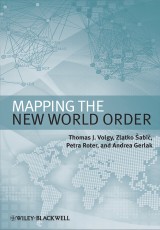Details

Mapping the New World Order
1. Aufl.
|
37,99 € |
|
| Verlag: | Wiley-Blackwell |
| Format: | |
| Veröffentl.: | 18.08.2009 |
| ISBN/EAN: | 9781444306569 |
| Sprache: | englisch |
| Anzahl Seiten: | 296 |
DRM-geschütztes eBook, Sie benötigen z.B. Adobe Digital Editions und eine Adobe ID zum Lesen.
Beschreibungen
This groundbreaking study maps out and analyzes the development of a global intergovernmental (IGO) institutional architecture in the post World War II era. <ul> <li>Systematically traces similarities and differences between the institutional architecture of the Cold War and post-Cold War eras</li> <li>Examines the range of reasons why states join IGOs, identifies patterns of participation within these organizations, and examines the effects of membership on states</li> <li>Considers the impact of the EU on other regional organizations and developments outside Europe</li> <li>Provides a strong contribution to the study of international organization and IGO development combining both quantitative and qualitative methodologies</li> </ul>
Preface. <p>1. In Search of the Post-Cold War World Order: Questions, Issues, and Perspectives (Thomas J. Volgy, Zlatko Šabič, Petra Roter, Elizabeth Fausett, and Stuart Rodgers).</p> <p>2. Mapping the Architecture of the New World Order: Continuity and Change in the Constellation of Post-Cold War Formal Intergovernmental Organizations (Thomas J. Volgy, Keith A. Grant, Elizabeth Fausett, and Stuart Rodgers).</p> <p>3. Accounting for the New World Order of FIGO Architecture and Its Effectiveness (Keith A. Grant, Thomas J. Volgy, Elizabeth Fausett, and Stuart Rodgers).</p> <p>4. Intergovernmental Organizations and Interstate Conflict: Parsing Out IGO Effects for Conflict in Post-Communist Space (Elizabeth Fausett and Thomas J. Volgy).</p> <p>5. The Correlates of Cooperative Institutions for International Rivers (Andrea K. Gerlak and Keith A. Grant).</p> <p>6. <a id="_Toc197528511" name="_Toc197528511"></a><a id="_Toc197521614" name="_Toc197521614">Substituting for Democratization: A Comparative A</a>nalysis of Involvement in Regional Intergovernmental Organizations (Stuart Rogers and Thomas J. Volgy).</p> <p>7. State Support for Human Rights Treaties (Petra Roter, Anuška Ferligoj and Andrej Mrvar).</p> <p>8. The Mediterranean As A Region in the Making (Ana Bojinović).</p> <p>9. Conclusions (Thomas J. Volgy, Zlatko Šabič, Petra Roter, Andrea Gerlak, Elizabeth Fausett, Keith A. Grant, and Stuart Rodgers).</p> <p>Index.</p>
<b>Thomas J. Volgy</b> is Professor of Political Science at the University of Arizona, and Executive Director of the International Studies Association. He has previously worked for USAID, USIA, and the National Democratic Institute in Central Asia, Eastern Europe, and Central America, and was recently an Atlantic Fellow. <p><b>Zlatko Šabič</b> is Professor of International Relations at the University of Ljubljana and Senior Research Fellow at the Centre of International Relations.<br /> <br /> <b>Petra Roter</b> is Assistant Professor of International Relations at the University of Ljubljana and Research Fellow at the Centre of International Relations. She is also GARNET Visiting Fellow at the Centre for the Study of Globalisation and Regionalisation at the University of Warwick.</p> <p><b>Andrea K. Gerlak</b> is Director of Academic Development for the International Studies Association and Visiting Professor in the Department of Political Science at the University of Arizona.</p>
This groundbreaking study maps out and analyzes the development of a global intergovernmental (IGO) institutional architecture in the post World War II era. The rich network of organizations that emerged from the Cold War is systematically compared with the growing web of organizations of the post-Cold War period and its acceleration through the remainder of the twentieth century. Combining both quantitative and qualitative methodologies, the authors examine the range of reasons why states join intergovernmental organizations and the patterns of participation within these organizations, as well as the consequences of the new architecture for issues as diverse as conflict amelioration, human rights, and cooperation on natural resources.<br /> <br /> Ranging over the multifunctional web of global, inter-regional, regional, and sub-regional organizations, this book provides a major contribution to the study of international organization and IGO development.
‘In <i>Mapping the New World Order,</i> Thomas J. Volgy and his colleagues answer one of the central questions of contemporary politics: Has the constellation of intergovernmental organizations (IGOs) changed since the end of the Cold War – and if so, how? To answer this question, the authors draw upon new data and new methods to map the births, deaths, regional concentrations, memberships and effects of formal IGOs from the Cold War to the 2000s, revealing subtle changes but also remarkable continuity in the basic institutional architecture of the post-Cold War world. Essential reading for any student of global governance.’ <br /> –<i>Mark A. Pollack, Temple University</i>


















